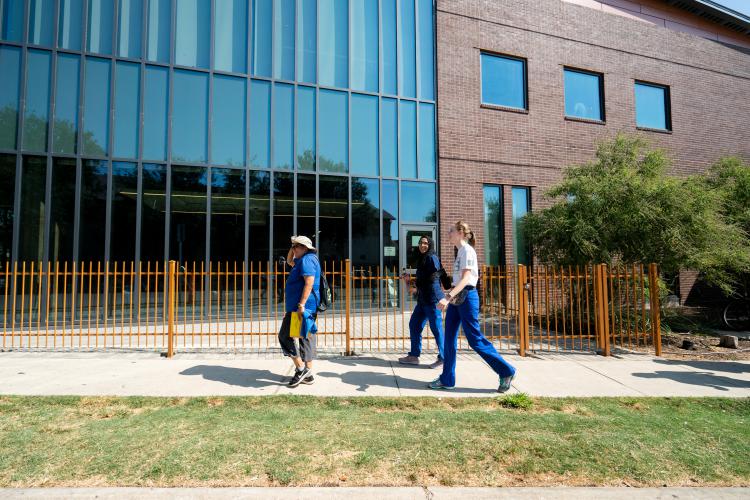
To get a firsthand look at the challenges homeless patients face when they’re discharged, a group of 28 JPS Health Network nurse residents braved triple-digit temperatures, hoping to learn how to navigate to places where services are available to those in need after they get out of the hospital.
“We thought it was important for our nurse residents to understand what our patient population faces when they’re released,” said Nurse Residency Program Manager Cherie Hall. “So we broke into six groups, each led by a facilitator from True Worth Place, and we went on a journey to seek out resources for our patients need. It really helped drive home the patient experience and it was certainly an eye-opener for all of us. It invoked a lot of insightfulness.”
Though on the day of the event the temperature peaked at 101 degrees, organizers never considered canceling the two and a half-mile, 45 minute walk from the JPS main campus to True Worth Place. On the way, they checked in on community partners including the Union Gospel Mission, the Men’s Presbyterian Shelter, My Health My Resources (MHMR), the Salvation Army and True Worth.
“It was a rough day, but it gave them a realistic experience,” Hall said. “The people we serve don’t have the option of just staying home because it’s hot, cold or raining. Still, we gave nurse residents the opportunity to opt out because of the conditions -- and they all overwhelmingly wanted to be there because it was such an important opportunity for them. One of the nurses told me even though he wouldn’t miss it, he was dreading it before we left. Afterword, he said he was so glad he did it.”
Shawn Massengil was one of the nurse residents who participated in the field trip.
“It was great experience,” Massengil said. “It was difficult to see the conditions people sometimes have to live in when they’re experiencing homelessness. But I was encouraged to find out about things I can share, recommend and suggest to newly-discharged patients to help them out.”
The experience is worth a million words.
Besides find where the places that have resources are located, the nurse residents also met with facilitators to find out what newly-discharged patients need to know to access them.
Jim Kneisel, an RN on P-5, said he was glad he made the trek to better appreciate the things homeless patients have to deal with.
“The hurdles and the obstacles people have to overcome to find care and get housing, it’s troubling, especially if they’re wheelchair bound or otherwise have trouble getting around,” Kneisel said. “It’s tough. They have to be back at the shelter by a certain time to find a bed for the night. That makes it hard to do what they need to do to get back on their feet. It was very humbling.”
While faced with the problems homeless patients must overcome, the field trip was also cause for optimism.
“The good news is that there are resources available,” Kneisel said. “It’s encouraging to learn how to link patients with things that will help them when they get out of the hospital.”
Joel Hunt, Director of JPS Care Connections, said the journey proved to be such a valuable experience that not only will it become a regular part of nurse residents’ training, it may also spread to other JPS departments in the future.
The trek to follow homeless patients will help reduce costs by keeping patients from having to be readmitted or returning to the emergency room, Hunt said. During the trip nurse residents learned little but important details including that discharging homeless patients at night puts them in danger as they try to get back to where they seek shelter and who to call when homeless people are being discharged instead of hurriedly searching for resources at the last minute.
“It’s very important to understand the perils of homelessness and what the patients have to navigate so you can grasp those factors translate into patient care,” Hunt said. “It’s a complicated situation. It’s not linear and there are all kinds of obstacles. So we visited the places, got a mental picture of what the environment is like patients are going to. The experience is worth a million words.”
